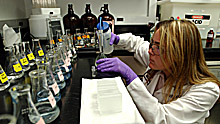 It has previously been discussed how to set up your home both on and off the grid. This including sourcing a water supply. Once a supply is established, there may be a need for water treatment, depending on a number of factors. Typically, a municipal water supply won’t need any further treatment for health reasons; this water is already handled by the municipality in its water treatment facility. You can treat it further, if you so choose, if you wish to remove substances added to the supply that you dislike, or if you wish to remove anything that may give the water an undesirable taste.
It has previously been discussed how to set up your home both on and off the grid. This including sourcing a water supply. Once a supply is established, there may be a need for water treatment, depending on a number of factors. Typically, a municipal water supply won’t need any further treatment for health reasons; this water is already handled by the municipality in its water treatment facility. You can treat it further, if you so choose, if you wish to remove substances added to the supply that you dislike, or if you wish to remove anything that may give the water an undesirable taste.
If you source your water from any other sources, such as wells, rain water collection, springs or a reservoir, it is highly recommended that water treatment take place prior to consumption.
 Before using this water, you must know what kind of treatment should happen, and an adequate water test should be done. The biggest concern with regard to water is whether or not there are any bacteria present. The only way to determine this is to send or take the water sample to a lab for testing. Usually your local university cooperative extension can perform this test, but another option is a commercially available kit found at your local hardware or home improvement store. These kits contain the sample containers along with instructions for sending it off for testing. Along with bacteria, these labs will also test for other contaminants, which will dictate what type of treatment should occur.
Before using this water, you must know what kind of treatment should happen, and an adequate water test should be done. The biggest concern with regard to water is whether or not there are any bacteria present. The only way to determine this is to send or take the water sample to a lab for testing. Usually your local university cooperative extension can perform this test, but another option is a commercially available kit found at your local hardware or home improvement store. These kits contain the sample containers along with instructions for sending it off for testing. Along with bacteria, these labs will also test for other contaminants, which will dictate what type of treatment should occur.
Bacteria are the first things to eliminate through treatment processes. The most cost effective and most commonly used method is via chlorination. In this method, a small feed pump injects a metered amount of chlorine into the water supply, which in turn kills off the bacteria. Another advantage is that the chlorine remains in the water supply thereafter, continuing to offer protection.
Other options include boiling, pasteurization and UV (ultraviolet) light. Boiling requires boiling the water for a minimum of three minutes. This is energy intensive and removes the carbon dioxide from the water, giving it a flat taste. Pasteurization requires heating the water to a certain temperature for a certain period of time, which is also very energy intensive. Like boiling, it is only good for that instance and provides no continual effects. A final option is subjecting the water to UV light. This method takes care of bacteria but leaves behind some other bio-contaminants such as cysts and worms.
 Once the water is treated for bacteria, it should be run through another filter to eliminate organic and inorganic compounds and minerals. This can be accomplished through a variety of means, namely mechanical, activated carbon, oxidizing or neutralizing filters along with reverse osmosis systems and distillation.
Once the water is treated for bacteria, it should be run through another filter to eliminate organic and inorganic compounds and minerals. This can be accomplished through a variety of means, namely mechanical, activated carbon, oxidizing or neutralizing filters along with reverse osmosis systems and distillation.
These methods all have their advantages and disadvantages and, like the various forms of disinfection, certain options are better suited for certain contaminants. You should carefully read the water test report to identify what contaminants are present, and select the filtration system suited for them.
The following are filtration options and for what they are best suited to remove:
- Mechanical filters (microfiltration): Well-suited for removal of suspended material including sand silt, clay and organic matter.
- Activated carbon filters: Absorbing impurities, eliminating undesirable odors and tastes, organic compounds and removal of residual chlorine.
- Oxidizing filters: Removal iron, manganese and hydrogen sulfide (rotten egg smell).
- Neutralizing filters: Treat acidic water.
- Reverse osmosis: Removal of inorganic compounds, most microorganisms and many organic compounds
- Distillation: Remove bacteria, minerals, trace amounts of metals, many organic chemicals and nitrates
Is your water comes back with substantial contamination, the best course of action is to try and find a new source of water, whether it is a well in a different area, an underground spring protected from animal contamination, or by hooking up to a municipal supply.
For more detailed information on the topics above, check out an excellent article written by the University of Missouri Extension titled Understanding Home Water Treatment Systems.